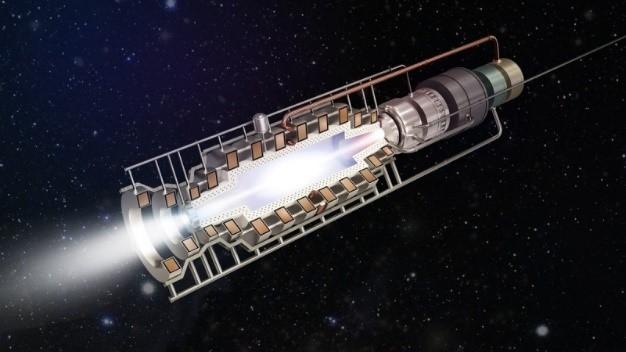
Nuclear energy in space. Atomic acceleration impulses
Content
The idea of using nuclear energy to propel spacecraft and use it in future extraterrestrial bases or settlements is not new. Recently, they have come in a new wave, and as they become a field of great power rivalry, their implementation becomes more likely.
NASA and the US Department of Energy began a search among dealer companies projects of nuclear power plants on the Moon and Mars. This should support long-term research and perhaps even settlement projects. NASA's goal is to have it ready for launch by 2026. The plant must be completely fabricated and assembled on Earth and then tested for safety.
Anthony Calomino, NASA's director of nuclear technology at the Space Technology Administration, said that The plan is to develop a XNUMX-kilowatt nuclear fission system that will eventually be launched and placed on the Moon. (one). It must be integrated with the lunar lander and the booster will take it to moon orbit. Loader then bring the system to the surface.
It is expected that upon arrival on site it will be immediately ready for operation, without the need for additional assembly or construction. The operation is a demonstration of the possibilities and will be the starting point for using the solution and its derivatives.
“Once the technology has been validated during a demonstration, future systems can be scaled up or multiple devices can be used together for long-term missions to the Moon and possibly Mars,” Calomino explained on CNBC. “Four units, each of which produces 10 kilowatts of electricity, will provide enough power to setting up an outpost on the Moon or Mars.
The ability to generate large amounts of electricity on the surface of planets using a ground-based fission system will enable large-scale research, human outposts, and use of resources in situ, while allowing for the possibility of commercialization.”
How it will work nuclear power plant? Slightly enriched form nuclear fuel strength of will nuclear core... Small nuclear reactor it will generate heat, which will be transferred to the power conversion system. The energy conversion system will consist of engines designed to run on reactor heat rather than combustible fuel. These engines use heat, convert it into electricity, which is conditioned and distributed to user equipment on the surface of the Moon and Mars. The method of heat dissipation is important to maintain the proper operating temperature of the devices.
Nuclear power is now regarded as the only reasonable alternative where solar energy, wind and hydropower are not readily available. On Mars, for example, the strength of the sun varies greatly with the seasons, and periodic dust storms can last for months.
On the moon cold lunar the night lasts 14 days, with sunlight varying greatly near the poles and absent from the permanently shadowed craters. In such difficult conditions, obtaining energy from sunlight is difficult, and fuel supplies are limited. Surface fission energy offers an easy, reliable and efficient solution.
Unlike ground reactorsthere is no intention to remove or replace the fuel. At the end of the 10-year mission, there is also a plan for the safe decommissioning of the facility. “At the end of its service life, the system will be turned off, and the radiation level will gradually decrease to a level that is safe for human access and operation,” Calomino explained. "Waste systems can be moved to a remote storage location where they will not endanger the crew or the environment."
Small, lightweight, but efficient reactor, in high demand
As space exploration develops, we are already doing quite well with nuclear power generation systems on a small scale. Such systems have long powered unmanned spacecraft that travel to the far reaches of the solar system.
In 2019, the nuclear-powered New Horizons spacecraft flew through the most distant object ever seen at close range, Ultima Thule, far beyond Pluto in a region known as the Kuiper belt. He couldn't have done it without nuclear power. Solar energy is not available in sufficient strength outside the orbit of Mars. Chemical sources do not last long because their energy density is too low and their mass is too large.
Used on long range missions radiothermal generators (RTG) uses the plutonium isotope 238Pu, which is ideal for generating permanent heat from natural radioactive decay by emitting alpha particles, which are then converted into electricity. Its 88 year half-life means it will serve a long-term mission. However, RTGs cannot provide the high specific power required for long missions, more massive ships, not to mention extraterrestrial bases.
A solution, for example, for an exploratory presence and possibly a settlement on Mars or the Moon could be small reactor designs that NASA has been testing for several years. These devices are known as Kilopower fission energy project (2), are designed to supply electrical power from 1 to 10 kW and can be configured as coordinated modules to power propulsion systems or to support research, mining or colonies on alien space bodies.
As you know, mass matters in space. reactor power it should not exceed the weight of an average vehicle. As we know, for example, from a recent show SpaceX Falcon Heavy rocketslaunching a car into space is currently not a technical problem. Thus, light reactors can be easily placed into orbit around the Earth and beyond.
2. XNUMX kilowatt KIlopower reactor prototype.
Rocket with reactor raises hopes and fears
Former NASA Administrator Jim Bridenstine he emphasized many times advantages of nuclear thermal engines, adding that more power in orbit could potentially allow orbiting craft to successfully evade if attacked by anti-satellite weapons.
Reactors in orbit they could also power powerful military lasers, which is also of great interest to US authorities. However, before a nuclear rocket engine makes its first flight, NASA must change its laws about getting nuclear materials into space. If this is true, then, according to NASA's plan, the first flight of a nuclear engine should take place in 2024.
However, the US appears to be jumpstarting its nuclear projects, especially after Russia announced a decade-long program to build a nuclear-powered civilian spacecraft. They were once the undisputed leader in space technology.
In the 60s, the United States had a project for the Orion pulse-pulse nuclear missile, which was supposed to be so powerful that it could allow moving entire cities into spaceand even make a manned flight to Alpha Centauri. All those old fantasy American series have been on the shelf since the 70s.
However, it's time to dust off the old concept. nuclear engine in spacemainly because competitors, in this case mainly Russia, have recently shown great interest in this technology. A nuclear thermal rocket could cut the flight time to Mars in half, perhaps even to a hundred days, which means astronauts consume fewer resources and less radiation load on the crew. In addition, as it seems, there will be no such dependence on "windows", that is, the multiple approach of Mars to the Earth every few years.
However, there is a risk, which includes the fact that the onboard reactor would be an additional source of radiation in a situation where space already carries a huge threat of this nature. That's not all. Nuclear thermal engine it cannot be launched in the Earth's atmosphere for fear of a possible explosion and contamination. Therefore, normal rockets are provided for launch. Therefore, we do not skip the most costly stage associated with the launch of mass into orbit from the Earth.
NASA research project called TREES (Nuclear Thermal Rocket Environmental Simulator) is one example of NASA's efforts to return to nuclear propulsion. In 2017, before there was any talk of a return to the technology, NASA awarded BWX Technologies a three-year, $19 million contract to develop the fuel components and reactors needed for construction. nuclear engine. One of NASA's newest space nuclear propulsion concepts is the Swarm-Probe ATEG Reactor, SPEAR(3), which is expected to use a new lightweight reactor moderator and advanced thermoelectric generators (ATEGs) to significantly reduce overall core mass.
This will require lowering the operating temperature and lowering the overall power level of the core. However, the reduced mass would require less propulsion power, resulting in a small, inexpensive, nuclear-powered electric spacecraft.
3. Visualization of the probe developed within the framework of the Swarm-Probe Enabling ATEG Reactor project.
Anatoly PerminovThis was announced by the head of the Federal Space Agency of Russia. will develop a nuclear-powered spacecraft for deep space travel, offering its own, original approach. The preliminary design was completed by 2013, and the next 9 years are planned for development. This system should be a combination of nuclear power generation with an ion propulsion system. Hot gas at 1500°C from the reactor should turn a turbine that turns a generator that generates electricity for the ion engine.
According to Perminov, the drive will be able to support a manned mission to Marsand astronauts could stay on the Red Planet for 30 days thanks to nuclear power. In total, a flight to Mars with a nuclear engine and constant acceleration would take six weeks instead of eight months, assuming a thrust 300 times greater than that of a chemical engine.
However, not everything is so smooth in the Russian program. In August 2019, a reactor exploded in Sarov, Russia on the shores of the White Sea, which was part of a rocket engine in the Baltic Sea. liquid fuel. It is not known whether this disaster is related to the Russian nuclear propulsion research program described above.
Undoubtedly, however, an element of rivalry between the United States and Russia, and possibly China on the ground use of nuclear energy in space gives research a strong accelerating impetus.
